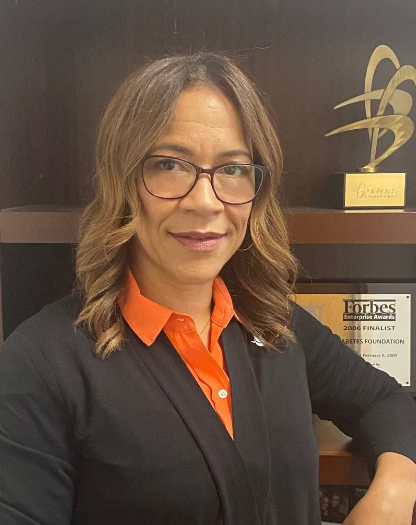My Personal Experience with Monitoring
Disclaimer: Please consult your personal medical team regarding your diabetes care. The following is a personal experience and opinion from a person living with diabetes. The views expressed are those of the author; they do not necessarily reflect the views of the Diabetes Foundation Inc.
 Diabetes is a balancing act. I feel like I am always walking on a balance beam. And it can be tough because you want to stand up straight and you want to balance. When you are diagnosed, you are suddenly sent out to the world. You are used to eating one way, and now you have to do it another way. I have had diabetes for 30 years now and I know firsthand how difficult it can be. I am constantly measuring and doing. My medical team of doctors and certified diabetes educators (CDE) still help me even after all this time. I will share my tips and tricks to manage my blood sugar that I’ve learned over the years.
Diabetes is a balancing act. I feel like I am always walking on a balance beam. And it can be tough because you want to stand up straight and you want to balance. When you are diagnosed, you are suddenly sent out to the world. You are used to eating one way, and now you have to do it another way. I have had diabetes for 30 years now and I know firsthand how difficult it can be. I am constantly measuring and doing. My medical team of doctors and certified diabetes educators (CDE) still help me even after all this time. I will share my tips and tricks to manage my blood sugar that I’ve learned over the years.
My general tips include:
1. Check blood sugar levels consistently.
I have a continuous glucose monitor (CGM) to check my blood sugar levels. However, you can also use a glucometer; a variety of brands are available on the market. My CGM allows me to use a phone app to see my blood sugar trends. Then, I can act upon when my blood sugar goes high or when my blood sugar goes low. The key here is to act when you see your blood sugar varying.
2. Wear a medical alert bracelet.
In an emergency, you should definitely have a medical alert bracelet on. Bystanders can report accurately, and first responders will understand how to help you. The Diabetes Foundation has an online resource dedicated to medical alert bracelets if you need one.
3. Learn food and beverages combinations that work for you at home.
Get in the habit of measuring and weighing your food and beverage portions and testing your blood sugar. Test your blood sugar 2 hours after you eat your meal. You do not want to take your blood sugar 5 or 20 minutes later. Your food is still going into your digestive system, and insulin is still working.
When you go out for outdoor dining or family gatherings, you will find eyeballing portions to be easier.
4. Feel the feelings – Be patient with yourself and keep a good attitude.
Diabetes has made me strong; I never ever, ever thought that I would be as tough as I am right now and be able to manage this disease. It sometimes feels like you’re alone because most people do not know about the daily routine of those living with diabetes. Share what you go through with some of your friends. I used to not talk about it, but I know now that sharing is important.
5. Have a sick plan in place.
If you notice that your blood sugars are rising rapidly and you cannot control them, you may be suffering from an illness. Call your doctor immediately to figure out how much of an increase of insulin is needed. We can all get confused when sick. Better yet, speak with your doctor in advance and come up with a sick plan.
For the Highs
When my blood sugars start to rapidly go up (180 and higher), I get a very, very bad headache. I start to feel exhausted and lethargic, and my head almost feels heavy like a bowling ball. Sometimes, the high affects my vision. I am lucky because there are many people who do not feel symptoms when their sugars are high. To bring them down, I do the following:
1. Determine personal correction levels with a healthcare professional.
You need to know this for everyday diabetes management. When you are experience an high, you need what your correction level is. Discuss this with your healthcare professional who will help you test and determine what is right for you.
2. Start exercising safely.
When blood sugar is going up, it is important to be active. I may do a bunch of jumping jacks to bring my blood sugar down a bit. Out of necessity, I have stopped driving, parked in a safe place, and started doing jumping jacks to bring my blood sugar down a little bit. People will sometimes look at me like I am a little crazy.
Also, I love to ride a bike, and bike riding for me is part of my exercise regime. Not everybody can ride a bike, and walking is a phenomenal alternative. It clears your mind and reduces stress. It’s important that you find what’s comfortable for you. I recommend the Diabetes Foundation’s Get Moving with Meaghan Donnelly, ACSM-CPT. Donnelly offers fabulous workouts sessions on Facebook Live, only 20 minutes and free!
3. Do calm & mindful breathing.
Yoga helps me to incorporate breathing into my daily lifestyle. I make sure to thread yoga into my workouts.
For the Lows
For my body, if I am dropping or going below 80, I start to sweat and shake, which leads to panicking. I steady myself and follow the below tips:
1. Carry supplies for the lows with you and know how to use them.
I carry glucose tablets, small juice packs, and peanut butter crackers. Every gram of a glucose tablet is typically 4 grams of a carbohydrate. They are fast acting. A small juice pack can be 7-9 grams. You have to figure out what works best for your body. This size really works for me. There are times that I need actually to have a little protein or snack. So, I like to snack on some peanut butter crackers.
2. Have patience.
We all want to eat everything in sight. When my blood sugar drops, I can be on a rampage and go through that refrigerator and try to eat and drink almost everything. With patience, I train myself to treat my low blood sugar by being sedentary and slowly working my way through it.
The most important thing is to test your blood sugar within 15-20 minutes after executing your low blood sugar plan.










